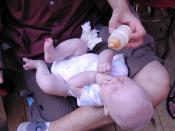Introduction
In order to analyse best practice in breastfeeding, it is important to examine application of existing policy, breastfeeding management under difficult circumstances, as well as developmental theory and family theory. In this way, a full picture can be drawn as a guideline for health professionals as well as the infant's mother and family. In 1991 the World Health Organisation (WHO) formalized a system of best practice called the Ten Steps to Successful Breastfeeding. The program was designed to overcome the barriers to breastfeeding that had become prevalent in hospitals throughout the world. Because policy and best practice are entwined, this system is used here as a framework for illustrating best practice.
In complicated breastfeeding circumstances, policies such as the WHO Ten Steps to Successful Breastfeeding, should still be used as a guideline, however modifications and addition strategies may need to be implemented - according to the complication. These complications may arise from conditions effecting the mother (such as sore/cracked nipples), or from conditions affecting the infant (such as being preterm).
Administrators and health care professionals have a key responsibility in supporting best practice in breastfeeding. The immediate outcomes of best practice policy should be the improved emotional and physical wellbeing of both mother and infant. Developmental and family theory however, can used to illustrate the rollover effect implementation of best practice can also bring to the family and wider society.
Best practice in normal breastfeeding circumstances
Over time a number of best practice recommendations have been established. The World Health Organisation's Ten Steps to Successful breastfeeding, as listed by Biancuzzo (2003: 182), provides an evidenced based approach for achieving better clinical outcomes. Application (and adaptations) of this approach have proven to be highly beneficial to mother, infant and family.
Step 1: Have a written breastfeeding policy that is routinely...


